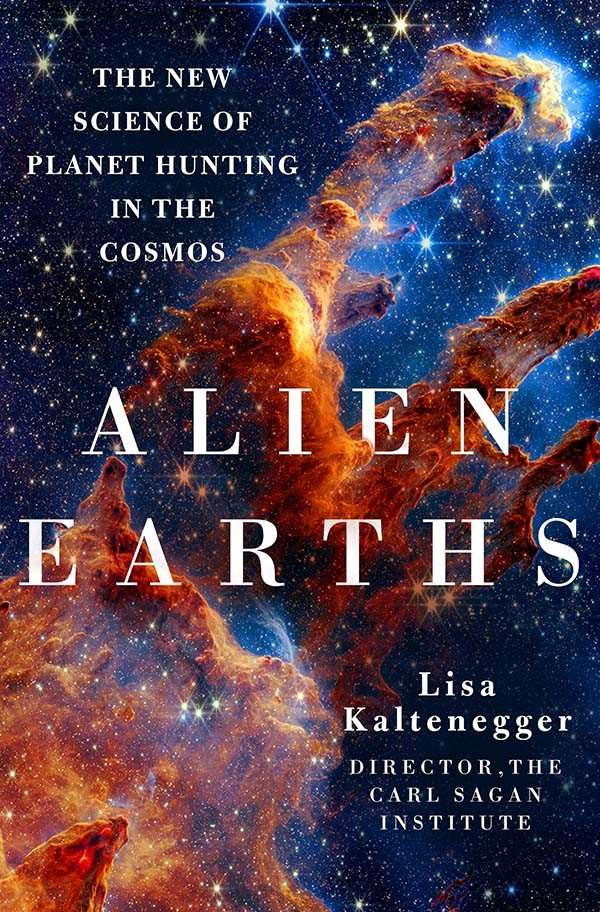New book gives insider’s view of cosmic search for life
By Linda B. Glaser
Whether life exists anywhere besides Earth is a burning question that, at long last, may soon be answered.
The clues we find on exoplanets could be as strange as a bioluminescent glow or a rainbow hue, as astronomer Lisa Kaltenegger describes in her accessible new book, “Alien Earths: The New Science of Planet Hunting in the Cosmos.”
The director of the Carl Sagan Institute (CSI) and associate professor of astronomy in the College of Arts and Sciences, Kaltenegger has been searching for life on other worlds for decades. In “Alien Earths,” to be published April 16, she describes her own personal and professional journey, and those of other pioneers as they track down answers to big questions, including a chapter that examines “What Is Life?” – and how can we identify it if we can’t even define it?
The book is featured in a Keynote on eCornell on April 16 at 2 p.m., and a Chats in the Stacks event on April 18 at 4:30 p.m., in-person at 160 Mann Library or online via Zoom.
Kaltenegger spoke with the Chronicle about her book:
Question: You share a good bit of your personal story in the book, interweaving it with the science, including being in on the ground floor of exoplanet research. What is it about searching for life in the universe that you find so compelling?
Answer: The first planet around another star like our Sun was discovered when I started college. That was fascinating, but I didn’t think that I could be part of it, because I’m from a very small town in a small country, Austria. And as a woman I just didn’t see anybody who looked like me doing this. But then I attended one of the first small conferences on the topic, just three years after the discovery. There weren’t many people there and the lively discussions between the scientists, professors and students about all these open questions showed that no one had answers yet. I remember several professors saying, “We need people to help us answer these questions – what do you think?” And all of a sudden, I was a part of the conversation about these new worlds. It was the first time that I got the impression that I could be part of this search, that I could actually help figure out if we are alone in the universe. That changed my world-view: I came back from that conference realizing that nobody had answers to these questions and trying to answer them was something everyone could be part of, including myself. And this is how I got into the field.
Q: You cover a huge range of scientific discoveries, from the question of how to define life to the dramatic variation in planet surfaces, which range from lava to ocean worlds. What do you see as the most important goal as we hunt for planets with life on them?
A: We need to find a biosphere that changes its planet. This is why I built the network of researchers from many different fields here at Cornell: the Carl Sagan Institute, which I founded nearly 10 years ago. To succeed in identifying signs of life in other worlds, we need to combine ideas from many different fields. My research team, for example, focuses on modeling how we could spot signs of life in the air or on the surface of Earth-like planets under different conditions, like under a red sun’s light or on worlds covered in oceans. But to do that, the diversity of life is another critical puzzle piece we need to add – like how different colors could uncover biota on other worlds. So I created the Color Catalog of Life, which is capturing more and more forms of life, because of inspiring collaborations in the CSI with colleagues in the microbiology and civil engineering department here at Cornell, as well as colleagues all over the world. If there is a combination of gases in the planet’s air that I can only explain with life, but I also found biopigments that life creates – a completely different line of evidence – then both together would make a much stronger case for life on another world.
These are just two pieces in the huge puzzle of how to find life in the cosmos. No single person can know all of science anymore; luckily there is just too much now to learn. The CSI has successfully connected thinkers all over Cornell, who tackle these questions together. It has been exciting to see the Carl Sagan Institute at Cornell grow and carry Carl Sagan’s legacy into the future.
Q: Through your descriptions of Earth’s evolution, you make the point that to understand other worlds we first have to understand our own, and vice versa. What have we learned from the study of other worlds that is important to understanding our own?
A: We don’t have much data yet, but for the first time it’s possible, with the James Webb Space Telescope, to explore other rocky worlds – from lava worlds that are so hot that rocks on the surface melt, covering it with lava oceans, to worlds that may be like ours. Studying other alien earths, some older and some younger than ours, will give us crucial insights into how an earth functions and what processes shape a planet like ours at different stages of its evolution. It may even provide a glimpse into our potential future. Such insights might even be able to help us address problems before they become severe on our own planet.
Linda B. Glaser is news and media relations manager for the College of Arts and Sciences.
Media Contact
Get Cornell news delivered right to your inbox.
Subscribe

